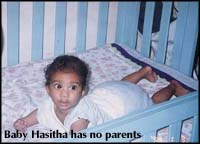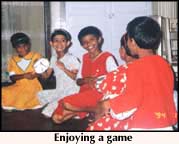
17th OCtober 1999
Front Page|
News/Comment|
Editorial/Opinion| Business|
Sports|
Sports Plus| Mirror Magazine

![]()
There's love in this Home
Text and pix by Hiranthi Fernando
 A
clean, well-run children's home with happy, smiling youngsters
is a pleasure to see. At the Peter Weerasekera Children's Home in Buthpitiya,
the youngsters do not lack care or comfort. It is truly a home away from
home, deserving indeed of the award of 'Best Children's Home in the Country',
bestowed on it by the Department of Probation and Child Care last year.
A
clean, well-run children's home with happy, smiling youngsters
is a pleasure to see. At the Peter Weerasekera Children's Home in Buthpitiya,
the youngsters do not lack care or comfort. It is truly a home away from
home, deserving indeed of the award of 'Best Children's Home in the Country',
bestowed on it by the Department of Probation and Child Care last year.
When we visited last Saturday, the sound of music and drumming greeted us. In a large hall, a group of girls of different ages were dancing, while others stood around clapping, having fun. These girls between five and 18 are from the main section, the Girls' Home.
The Peter Weerasekera Children's Home and Nutrition Centre is on a five acre property at Buthpitiya, close to Yakkala on the Kandy Road. The Girls' Home opened 40 years ago, is housed in the ancestral home of Mudliyar and Mrs. Peter Weerasekera, donated to this worthy cause by their son Singha. "Run under the umbrella of the All Ceylon Women's Buddhist Congress, the home, which initially took in 28 destitute girls, was financially helped by well wishers," said Mrs. Mala Weerasekera, wife of Singha Weerasekera. At that time, the estate, which included a paddy field, provided the rice and coconuts. The people in the village provided most of the meals.
"It was a tough time from 1970 to 1977," Mrs. Weerasekera recalled. "Funds were difficult and we did not know where the next meal was coming from." The situation changed when the Social Services Department called Mrs. Weerasekera to say that a lady from the International Children's Aid of Australia was looking for a children's home to assist. Mrs. Weerasekera invited her to visit the Peter Weerasekera Home. Happy with what she saw, Mrs. Penny Brune decided to adopt the home. Regular monthly donations were sent from the International Children's Aid, Australia. They also participated in building a Nutrition Centre in 1980, for abandoned, malnourished infants. The children were from hospitals and other centres directed through the Probation and Child Care Department. "Mrs. Penny Brune was like a beacon of light to us," Mrs Weerasekera said.
Today, the Home has room for 40 in the Girls' Home, 30 in the Nutrition Centre and 30 in the Toddlers' Home, which was opened in 1987. Each section is equipped with its own kitchen so that meals are cooked and served separately. The home is partly funded by the International Children's Aid, Australia. The balance has to be raised through other benefactors locally.
In the Special Care Unit of the Nutrition Centre, are three lovable babies between five and seven months. Looking well nourished and cared for, it was hard to think that they had been abandoned and malnourished just a few months ago. Baby Sanduni five months old, was born to a 12-year-old who could not look after her. The young mother is now back at school. Seven-month-old Sasini's mother is mentally handicapped. The third baby Hasitha has no parents. He was taken over from the courts through the Department of Probation and Child Care.
Nimalee Weerasekera, who handles the overall running of the Home is enthusiastic and dedicated. She explained that when malnourished children are brought in, they are kept in Unit 1, where they are given the extra care they need. "They often come with scabies, skin rashes and various other problems. When the Nutrition Centre was opened, Mrs. Brune sent nurses from Australia for six month periods. They worked with the local staff. The Centre is now handled by a qualified Sri Lankan nursing sister. Ranjini who helps to look after the babies has also been brought up at the Girls' Home since she was four. She and two other older girls sleep in the adjoining room and work in shifts. "Ranjini mothers all the babies and is doing a wonderful job," Nimalee said.
In the next unit of the Nutrition Centre, there were toddlers who had been through Unit 1. Bedrooms were furnished with neatly made-up cots. A dining room with small chairs and tables and a kitchen completed this section. The cleanly dressed toddlers were running about playing happily. Among these toddlers were Rashmi and Sachini, identical twins. They had lost their mother at five months due to cancer.
Dressed in identical red and white suits, were triplets Madushanka, Asanka and Chaturanga.
 The
older children from the third unit of the Nutrition Centre are transferred
to the Toddlers' Home when their health is stabilized. The Toddlers Home
is accommodated in a new building built for the purpose. There were rows
of blue painted beds with half railings in the cheerful, airy dormitory.
Each bed had on it the child's favourite doll or soft toy. A large hall
in the Toddlers' Home served as a Montessori School. The children were
enjoying their class, with one child playing 'teacher'.
The
older children from the third unit of the Nutrition Centre are transferred
to the Toddlers' Home when their health is stabilized. The Toddlers Home
is accommodated in a new building built for the purpose. There were rows
of blue painted beds with half railings in the cheerful, airy dormitory.
Each bed had on it the child's favourite doll or soft toy. A large hall
in the Toddlers' Home served as a Montessori School. The children were
enjoying their class, with one child playing 'teacher'.
Srimathi Perera, a retired principal, is the administrative co-ordinator. She explained that the girls have been divided into three houses, Olu, Nelun and Manel. They take turns to clean the premises, help in the kitchen and cultivation. "As girls it is important that they know to look after and run a house," she said. A well equipped pantry donated by the Ceylon Australia New Zealand Association (CANZA) gives the older girls an opportunity of learning culinary skills. We were served with cake and short eats made by Nirosha, who has sat the A'Levels and is now attending computer classes. Nirosha is also a keen gardener.
The children at the Peter Weerasekera Home have been admitted with the authority of the Department of Probation and Child Care. Many are orphans while some have one parent. Some have been abandoned whilst others have parents who are unable to care for them. Tharaka Sandamali and Nirasha Rukmali are twins aged 12. "I cannot distinguish one from the other," said Nimalee Weerasekera. She explained that the parents of the twins are both blind. They have four other children.
When the girls reach 18, the management tries to find suitable employment for them. Many of them are employed in the home. The Matron herself was one of the first girls to be admitted to the home. Last year, two marriages took place at the home. "Lalitha, who has no parents, was about five when she came to the Home," Nimalee said. "We had her engagement and wedding here. She is employed here but at present is on leave as she is pregnant." Chandrika, who is 21, has been at the Home since she was four. She too is happily married and expecting her first child. Shirani, yet another girl from the Home is now in Geneva, married and bringing up her family of two children. She has built a home for her mother here.
Starting with 28 destitute girls, the Peter Weerasekera Home has expanded into a well run complex caring for almost a hundred children. The Weerasekera family works in close association with the management of the Home. A trust fund has been set up with an initial donation from the President's Fund, to ensure the future running of the home. It is particularly commendable that the Peter Weerasekera Home not only cares for the children while they are in the Home but also looks to their future wellbeing.








![]()
Front Page| News/Comment| Editorial/Opinion| Plus| Business| Sports| Sports Plus| Mirror Magazine
Please send your comments and suggestions on this web site to

